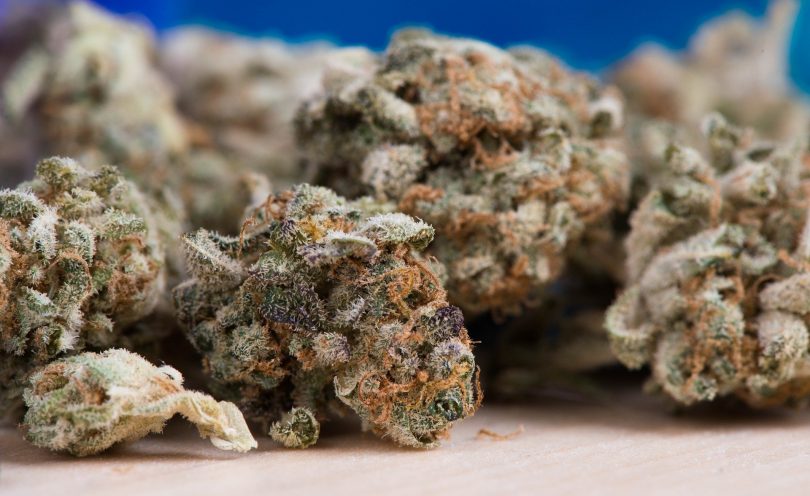Is one better than the other?
For eons, the debate has raged. Outdoor cannabis cultivators point to the unparalleled power of sunlight, reduced costs, and improved sustainability. Indoor cannabis cultivators enjoy god-like environmental control, extra harvests, and superb aesthetics. Each cultivation choice is a double-edged sword with pros and cons. But is one really better than the other?
Let’s look at the chemical differences. A 2016 study in Forensic Science International compared the lipid content of flowers collected from 84 indoor and outdoor cultivation sites across 18 states. Researchers found significantly higher paraffin wax content across all outdoor samples. Additionally, outdoor plants had more lower weight n-alkanes (biomarkers synthesized in leaf wax). These differences likely reflect sunlight and photoperiod. [1]
Cultivators might shrug off these distinctions, but what about cannabinoid and terpene content?
Indoor cultivation is commonly considered to produce more potent cannabis, but this has not been evaluated scientifically. In fact, environmental stress (such as UV-B radiation from sunlight [2]) may elevate tetrahydrocannabinol (THC).
Artificial lighting variably mimics sunlight. For example, LED lighting may produce higher cannabidiol (CBD) and THC concentrations but lower yield compared to high pressure sodium lighting. [3] Lighting designers at Black Dog LED, however, have optimized their light spectrum to provide the wavelengths needed for high yield flower production, including a portion of UV light to best mimic sunlight and enhance cannabinoid concentration.
Indoor cultivators can control photoperiod, temperature, and harvest timing with utmost precision, affording greater chemical uniformity. [4] Varying environmental conditions could result in variable potency for outdoor crops.
How about yield?
Outdoor cultivators may push plant height upwards of 20 feet with abundant fresh air and sunlight. [5] Massive plants produce massive yields, but the cultivator faces limitations on number of harvests (i.e., once a year). Cross-pollination from outdoor air is a wild card threat that may require physical isolation (at least 10 miles from foreign cannabis plants).
Indoor cultivators typically grow much smaller plants but may maintain a perpetual harvest (with grow rooms for each stage of development). This requires extreme environmental controls: light, temperature, humidity, CO2, etc. But it can also produce tremendous and continuous yields. [6] And the flowers are generally well-preserved and aesthetically pleasing.
It’s hard to deny that outdoor cultivation is cheaper and more sustainable. Natural enemies like ladybugs and predatory mites help the outdoor cultivator reduce pesticide use. And in 2012, Energy Use equated one kilogram of indoor cannabis product with 3 million cars worth of CO2 emissions. [7] Ouch.
One budtender aptly compares indoor and outdoor to recorded and live music, respectively. Recorded music has a more polished finish, but live music is more natural and organic (albeit imperfect). Which cultivation style is ‘better’ comes down to the individual. Because hey, rock n’roll is rock n’roll.
References
- Tipple, Brett J., et al. “The Influences of Cultivation Setting on Inflorescence Lipid Distributions, Concentrations, and Carbon Isotope Ratios of Cannabis Sp.” Forensic Science International, vol. 262, 2016, pp. 233–241, doi:10.1016/j.forsciint.2016.03.029. Impact Factor = 1.947 Times Cited = 4
- Lydon, John, et al. “UV-B Radiation Effects on Photosynthesis, Growth and Cannabinoid Production of Two Cannabis Sativa Chemotypes.” Photochemistry and Photobiology, vol. 46, no. 2, 1987, pp. 201–206, doi:10.1111/j.1751-1097.1987.tb04757.x. Impact Factor = 2.214 Times Cited = 36
- Magagnini, Gianmaria, et al. “The Effect of Light Spectrum on the Morphology and Cannabinoid Content of Cannabis Sativa L.” Medical Cannabis and Cannabinoids, vol. 1, no. 1, Dec. 2018, pp. 19–27, doi:10.1159/000489030. Impact Factor = NA Times Cited = 4
- Chandra, Suman, et al. “Cannabis Cultivation: Methodological Issues for Obtaining Medical-Grade Product.” Epilepsy & Behavior, vol. 70, 2017, pp. 302–312, doi:10.1016/j.yebeh.2016.11.029. Impact Factor = 2.378 Times Cited = 17
- Certanes, Jorge. “Chapter Seven: Outdoors.” Marijuana Horticulture: The Indoor/Outdoor Medical Grower’s Bible, 2006, Google Books.
- Jin, Dan, et al. “Cannabis Indoor Growing Conditions, Management Practices, and Post-Harvest Treatment: A Review.” American Journal of Plant Sciences, vol. 10, no. 06, 2019, pp. 925–946., doi:10.4236/ajps.2019.106067. Impact Factor = NA Times Cited = NA
- Mills, Evan. “The Carbon Footprint of Indoor Cannabis Production.” Energy Policy, vol. 46, 2012, pp. 58–67, doi:10.1016/j.enpol.2012.03.023. Impact Factor = 4.039, Times Cited = 26









whoaһ thiѕ blog іs fantastic i love reаdіng
your posts. Kеep up the good work! You knoԝ, lots of persons
are searching round for this info, you can heⅼp them greatly.